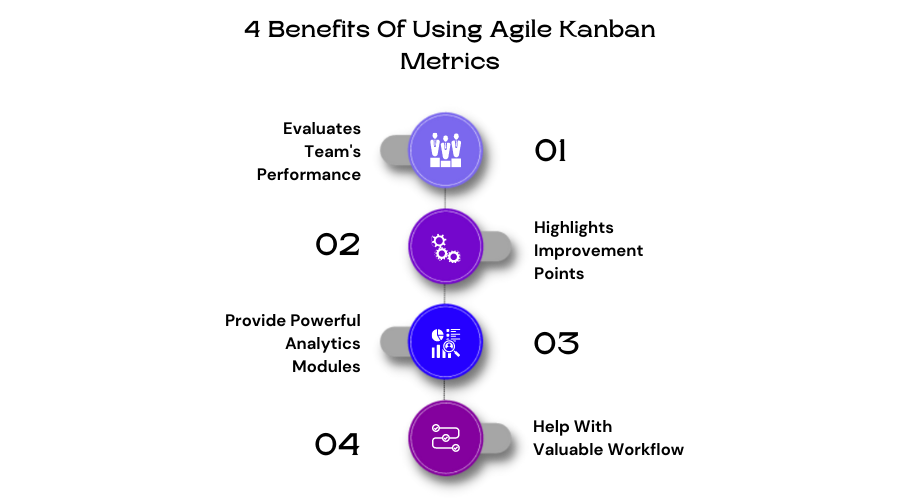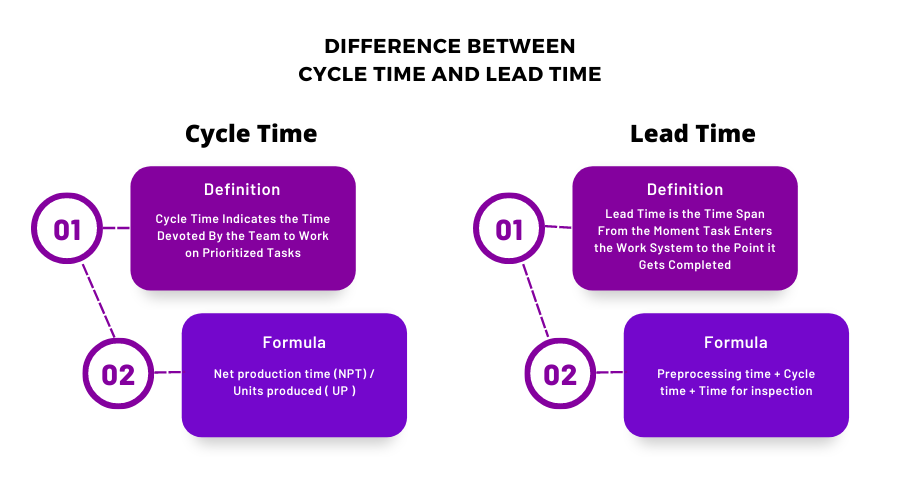How to Estimate in Kanban & Agile Kanban Metrics

This article covers:
- How to Estimate in Kanban
- How to Measure Kanban Performance
- Is There a Primary Metric in Kanban?
- What Are Some Agile Kanban Metrics?
- Importance of Agile Kanban Metrics
- What Is Lead Time in Kanban?
- Average Lead Time Measured in a Kanban System
- What Is the Kanban Lead Time Calculation?
- What Is Cycle Time in Kanban?
- What Is the Difference Between Lead Time and Cycle Time in Kanban?
- What Is Throughput in Kanban?
- What Are Some Kanban Throughput Metrics?
- What Is the Kanban Throughput Calculation?
- What Is Work in Progress in Kanban?
- Conclusion
Introduction
Kanban is a popular method stemming from the agile methodology for organizing priorities and aligning product teams across various industries.
While kanban is known for its board, learning to measure progress and estimate goals in kanban is part of any successful product manager’s strategy.
This article will cover how to estimate kanban and practical calculations you can use when developing products in kanban methodology.
How to Estimate in Kanban
Before we dive into understanding how to estimate in kanban, let’s start by understanding what an estimate is.
An estimate in kanban refers to how we understand how much work is required to complete a user story.
You should note that there are no set estimates but are rather flexible.
You can produce more or less than what was initially estimated, depending on the circumstances.
We estimate in kanban because we want to know how much work is in the system and ensure we have enough capacity.
This way, we can prioritize the tasks and develop a release plan for the customers.

Try Chisel’s free forever plan today!
The steps to estimate in kanban are:
- Determine the question or statement you want to estimate in kanban that your team understands clearly.
- Create a visual representation of this estimation using cards.
- Create a backlog and list all the tasks.
- Sort the tasks by criticality. Start with high-priority ones first to create a release plan.
- Estimate how much time each task will take according to what’s needed (e.g., design, coding, testing).
Bonus: Click here to learn about best practices to implement in kanban methodology.
Some of the challenges while estimating in kanban are about asking the following questions:
- How do you account for different skill levels and team sizes?
- What about risk factors that may delay the entire project?
- How do you decide when a task is complete?
- How will other tasks be impacted by this one getting completed or not completing it on time?
To be able to answer these questions, it is essential to be able to measure first.
That’s why you can additionally use some agile kanban to estimate kanban.
How to Measure Kanban Performance
Now that we examined how to estimate kanban, it’s essential to know how to measure kanban performance.
You need to know how to measure kanban performance because it can help you make adjustments to your process or team.
Cameron Turner, Product Manager of LuckLuckGo, indicates that by utilizing Kanban metrics, he could optimize his workflow by 20% within a month.
Kanban performance can be measured using the agile kanban metrics we further explain in this article.
Is There a Primary Metric in Kanban?
The answer to that question is that it depends.
It’s important to know that there is no “one-size-fits-all” metric.
Each measurement of kanban performance can be tailored and used depending on the context of your organization.
Hence, you should consider which metrics are more relevant to your business needs before committing to one type of measurement.
What Are Some Agile Kanban Metrics?
Agile kanban metrics get implemented to track the team’s progress and gain insights into how efficiently work gets completed.
The metrics are collected during a workflow to evaluate performance at various points in time, rather than assessing productivity over an entire project cycle.
Managers, scrum masters, and teams mostly use agile kanban metrics
Managers may use metrics to track what’s going on with their team and assess individual members’ performance.
Scrum masters are responsible for tracking how much work a team is completing each day or week. They can help facilitate better planning in the future while also holding individuals accountable for what they’re doing.
Bonus: Want to know what role a scrum master plays in an organization? Then, click here.
Of course, the scrum master comes into play only when you combine kanban with scrum in cases such as scrumban and kanplan.
Importance of Agile Kanban Metrics
Agile kanban metrics are essential because they provide insights into how to work more efficiently.
They may also reveal potential bottlenecks in the workflow or tasks that are taking too long.
You can employ agile kanban metrics at each point in time as a benchmark against which you can measure future performance. It is beneficial if some changes have gotten implemented recently.
The most commonly used agile kanban metrics are the following:
- Lead Time – Average Lead Time to complete a work unit.
- Cycle Time – Actual time spent working on producing a service or an item.
- Throughput – the number of units passing through a process in a specific period, usually defined by hours, days, or weeks.
- Work in Progress (WIP) – the number of tasks or work items your team has on their plates at any given time.

What Is Lead Time in Kanban?
Lead time in kanban refers to the time it takes for a task to move from one production stage to the next.
It refers to the time that elapses between creating and delivering an item by a company or individual.
Lead time in kanban is the amount of time taken from when a request is made to when the task or product is released.
In other words, lead time in kanban is the waiting period for the client during which their request gets fulfilled.
Kanban models use the lead time to measure customer satisfaction.
Lead time in kanban is a critical metric because it determines what the team can work on next and what will get started when.
One of the ways to keep lead time low is by limiting how many tasks are in progress at one time with a kanban system.
That means there’s less chance for bottlenecks or task failures due to resource constraints like idle workers or equipment.
We use lead time in kanban to determine how long it will take to complete a task.
For example, if you have five tasks that take two hours for the team to finish, your total lead time would be ten hours (the sum of all tasks).
To calculate the lead time in kanban, subtract the time you receive an order from the time the order is delivered.
Lead time = order delivered – Order received
For instance, if you received the order on July 5th, 2021, and delivered the order on July 12th, 2021, then lead time equals 12 minus 5, which is 7. Hence, the lead time is seven days.
Average Lead Time Measured in a Kanban System
What is the average lead time measured in a kanban system?
Lead time measures the amount of time that a task takes the moment the team starts working on it.
Lead times are calculated by summing up all the tasks’ completion times and dividing them by their total number.
To measure average lead time in kanban, use the following formula.
Average lead time = Total lead – Time / Number of completed tasks
Average lead time in kanban is a critical metric because it can be a helpful indicator of how quickly your team completes work.
The average lead time will give you an idea about the average amount of time it takes for tasks to complete.
Thus, they help you understand how long processes take in general and the average wait experienced by customers or users before they receive their request.
If you are a product manager or team lead, average lead time in kanban is an important metric. It will allow you to easily spot any potential issues and do something about them, like adding resources and switching processes.
Lead times come in various forms, with the average lead time being just one metric that can be measured and tracked on an agile team’s kanban board or software tool.
The critical difference between average lead time and lead time in kanban is that average lead time gets calculated in days elapsed from when work begins.
Lead time, however, refers to how many days a task should take if you complete it at an average pace.
One limitation of average lead time is that it doesn’t consider what the team is working on or trying to achieve. It means that variability in work can distort data.
Another limitation of using average lead time as a metric is that one project can have an abnormally long completion period. It can also cause delays in other projects with shorter deadlines.
What Is the Kanban Lead Time Calculation?
The kanban lead time calculation is the average time it takes to move a card across the board.
It can be calculated by adding up all the “lead times” for each column in your Kanban board and dividing that number by the total cards (or tasks) completed on that board’s columns.
It will give you the required lead time before moving on to the next part of the kanban board.
What Is Cycle Time in Kanban?
Cycle time in kanban is a metric that measures the time a task takes to pass through the kanban workflow.
You calculate the cycle time from the moment your team starts working on the task until your team completes the task doesn’t account for the order and delivery of the task.
Make sure you don’t confuse lead time and cycle time in kanban.
In contrast with lead time, cycle time solely measures the production rate during the developmental process.
In other words, it calculates the time taken by a task in the kanban workflow.
You calculate cycle time through the internal perspective to improve productivity.
However, the client’s perspective is the lead time to improve customer satisfaction.
The formula to calculate cycle time is as follows:
Cycle time = Net Production time / Number of units produced in the Net production time.
What Is the Difference Between Lead Time and Cycle Time in Kanban?
The difference between lead time and cycle time in kanban is that lead time is the average amount of time it takes for a task to move across one row in your kanban board.
Cycle time, on the other hand, is how long tasks take from start to finish and can be calculated by adding up all the “lead times” for each column in your kanban board and dividing that number by the total cards.

What Is Throughput in Kanban?
In contrast with cycle time, throughput measures work items you have completed in a certain period.
Remember that throughput only includes completed tasks. Hence, it doesn’t have the tasks that are still in progress.
Throughput helps determine your team’s capacity to deliver a certain amount of completed tasks in a fixed period.
Consider a team that delivers items 4, 6, 7, and 7 in four weeks to give you an example of throughput.
Hence, without considering other factors, we can understand that the average throughput would be six weekly items.
It means that the team can complete approximately six deliverable items every week.
Over a while, you can track team performance through a throughput histogram.
If your throughput increases or stays the same over a while, it indicates that your team is functioning efficiently.
However, if it decreases, it indicates the occurrence of a scope creep or hindrance in productivity.
What Are Some Kanban Throughput Metrics?
Some kanban throughput metrics include:
- The average lead time for all tasks is in your kanban board’s “In Progress” column.
- Cycle times, or how long each task takes.
These metrics can help you to identify which tasks need more time and effort to get done.
What Is the Kanban Throughput Calculation?
The kanban throughput calculation is the number of cards that pass through a kanban board in the specified period.
It is calculated by adding up all the “lead times” for each column and dividing that total by the total cards on your kanban board.
What Is Work in Progress in Kanban?
Work in progress is a section on the kanban board where all the work currently undertaken by the team but not completed is listed.
Keeping the tasks under this section as low as possible is essential.
The lower number of items in the work-in-progress section assures that there is no chance of multitasking as divided attention. Hence, all the team members can collectively or individually focus on one particular task.
You can determine the optimal number of tasks in this section by the number of members in your team.
You should limit the number of team members you can have.
This way, everyone can focus on one task at a time.
Conclusion
Using these kanban metrics and calculations only helps you accomplish your goals as a product manager.
Chisel’s platform makes it easy for you to have an organized kanban to engage in such calculations.
Moreover, Chisel integrates a kanban board and prioritization matrix to help you save time and focus on the most critical tasks.
You may also be interested in:
- Why to Use Kanban
- How to Start Implementing Kanban
- Top 9 Scrum Master Certifications and Their Value
- Most Popular Agile Certifications To Consider
- Product Development Method Tradeoffs
- Dual Track Agile: Scrum + Kanban
- 9 Best Kanban Board Software
- Here’s What You Don’t Know About Kanban vs. Scrum That Could Harm Your Business
